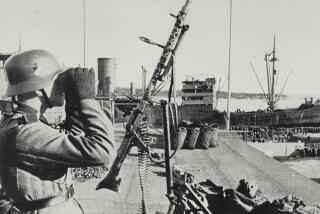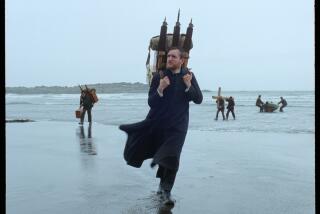‘Vikings’ Retraces Norse Way of Life
- Share via
Just about every American child learns in school that Christopher Columbus “discovered” America--or, more accurately, a small island in the Caribbean--in 1492.
What isn’t always taught is that the Norse arrived in North America centuries before Columbus set sail for the New World. In the year 1000, Leif Ericson led a small group of Scandinavian adventurers from Greenland to the northern tip of Newfoundland, Canada.
The Smithsonian’s National Museum of Natural History in Washington, D.C., last year unveiled an exhibition designed to celebrate the millennium of Ericson’s arrival in North America and to shed more light on this often marginalized aspect of our continental history. On Saturday, the exhibition arrives at the Natural History Museum of Los Angeles County.
Featuring more than 300 objects, “Vikings: The North Atlantic Saga” will call the museum home through March 17.
Historic Scandinavian documents known as the Vinland Sagas have spoken of Ericson’s journey to North America for centuries. But physical evidence substantiating these claims didn’t exist until 1960, when Viking artifacts were unearthed in Newfoundland.
“There’s never really been an exhibition of this sort to really let the American public know about [the Norse presence in North America],” says Elisabeth Ward, the exhibition’s assistant curator. “So a lot of people haven’t had a chance to hear and learn about it. So we feel really honored to be able to bring this information to the public in a popular format.”
The common perception of the Norse during this period is of marauding Vikings rampaging through Europe. But the vast majority of Scandinavians were farmers, and the ones who ventured west to Iceland, Greenland and then North America were not technically Vikings, since pillaging was not part of their agenda. (Iceland and Greenland were largely uninhabited at the time.)
“Vikings: The North Atlantic Saga” primarily documents the westward migration of the Norse and illuminates the type of life the Scandinavians lived both abroad and at home.
Ward says some Nordic people moved west to escape the consolidation of power into fewer hands in Scandinavia and the institutionalization of Christianity. For centuries, the Norse were pagans who lived in diffuse communities governed by chieftains.
This pagan period was especially beneficial to Scandinavian women. They were allowed to hold political office and own, trade and inherit property--rights that would decline under Christianity.
Among the highlights of “Vikings: The North Atlantic Saga” are four original 13th and 14th century manuscripts documenting Norse history and life. When Christianity became the main religion in Scandinavia, the Nordic oral tradition was finally put into writing.
“The four original manuscripts in the exhibition required an act of [Icelandic] parliament to get loaned to the exhibition,” Ward says. Indeed, the Norse established the first known parliamentary system in 930 after they relocated to Iceland. The details of this system are explained in one of the four manuscripts on display.
The exhibition presents the pre-Christian oral tradition in Scandinavia through prerecorded stories. Visitors can listen to aspects of the Vinland Sagas while sitting in a partial replica of a Norse longhouse. A video also explains the construction of longhouses.
Archeologists unearthed remnants of three Norse longhouses at Ericson’s settlement at L’Anse aux Meadows in Newfoundland. Each longhouse was designed to house 30 or 40 people.
Trond Woxen, a Viking storyteller, will also tell Norse tales at the Natural History Museum on selected weekends during the exhibition’s run. He will perform this Saturday and Sunday between 1 and 4 p.m.
A scale replica of a Viking ship will be another main attraction of the exhibition. The original sailing vessel was found around Oslo Fiord in Norway. The Norse were known as master shipbuilders and were the first Northern Europeans to use sails.
Another object in the exhibition is a whalebone ironing board. “This ironing board was found in a woman’s burial [site] along with a very heavy glass,” notes Ward, whose mother is Icelandic. “The two of them were found next to each other. So it seems like this piece of glass is what they would have used to smooth out women’s undergarments.”
One section of the exhibition is devoted to the Vikings’ history of pillaging and violence in Europe. Included is a case of Viking axes and swords and a display of looted items. The original Norse settlement in Newfoundland was brief, mainly due to the Scandinavians’ inability to exist peacefully with Native Americans. Archeological evidence suggests that the main Norse activity in Newfoundland was building ships, since this area offered much more wood than Greenland and Iceland.
However, the Norse continued to visit North America. There is evidence that they were in the New World up until the 1350s, though nothing suggests they ever made it south into what became the U.S.
“We found a [Norse] penny in Maine, which is part of the exhibition,” Ward notes.
“That coin was actually found in a native village. It doesn’t indicate the presence of Vikings in the U.S., rather that native peoples had contact with other native peoples that had met and perhaps traded with the Vikings.”
“Vikings: The North Atlantic Saga,” Natural History Museum of Los Angeles County, 900 Exposition Blvd., Exposition Park, Los Angeles. This Saturday through March 17. Museum hours: Saturday-Sunday, 10 a.m.-5 p.m.; weekdays, 9:30 a.m.-5 p.m. $8; students with ID and over age 62, $5.50; ages 5-12, $2; under age 5, free. (213) 763-DINO or www.nhm.org.
More to Read
Sign up for The Wild
We’ll help you find the best places to hike, bike and run, as well as the perfect silent spots for meditation and yoga.
You may occasionally receive promotional content from the Los Angeles Times.






